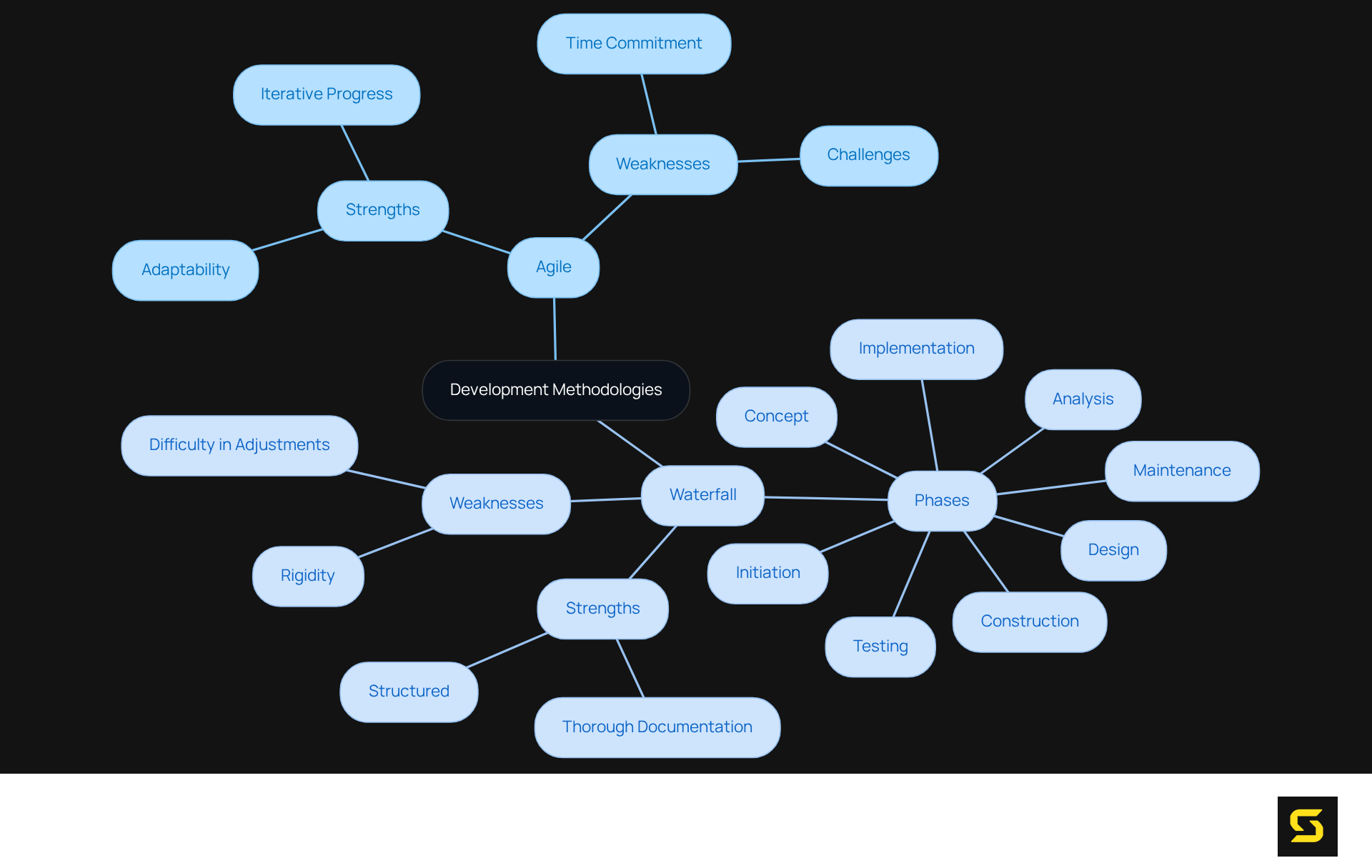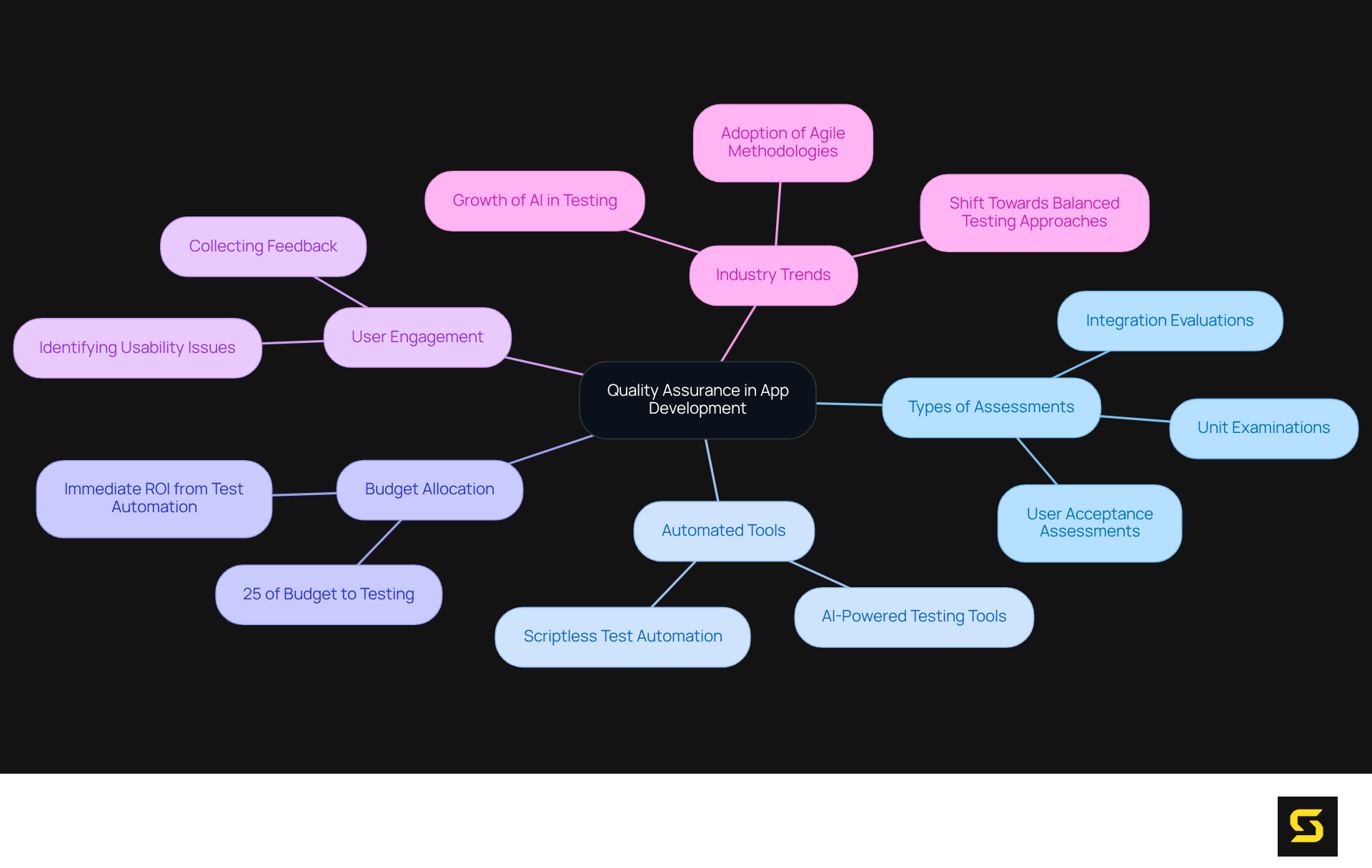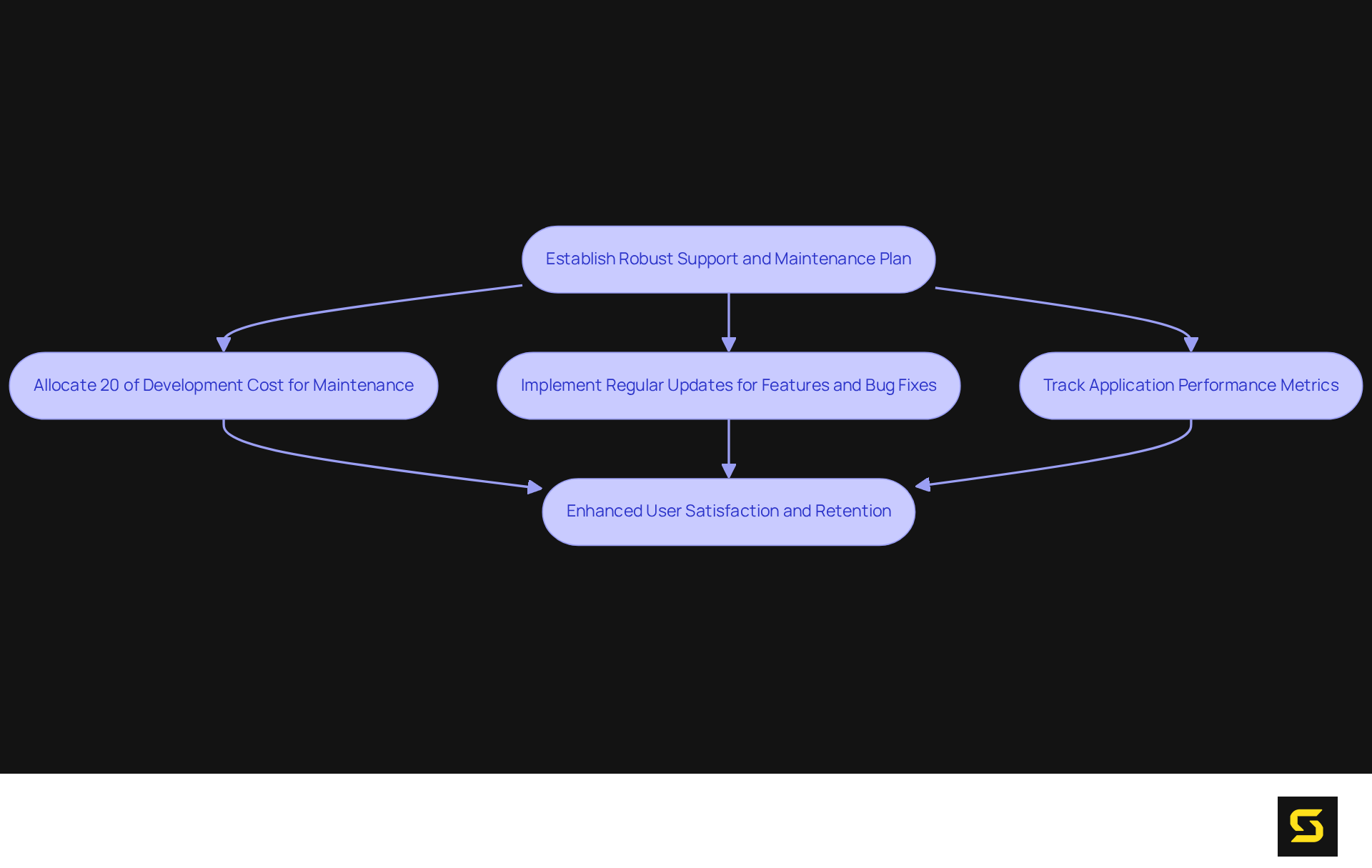Overview
To achieve success in custom app development, four key practices must be prioritized:
- Defining clear requirements and objectives
- Selecting the appropriate development methodology
- Implementing comprehensive testing and quality assurance
- Ensuring continuous support and maintenance
These practices are not merely suggestions; they are essential for aligning stakeholder expectations, adapting to project needs, maintaining high-quality standards, and fostering long-term user satisfaction. By adhering to these principles, you significantly enhance the overall effectiveness and longevity of your application. Embrace these practices to secure your project's success and ensure it meets the evolving demands of users.
Introduction
In today's digital landscape, the demand for custom applications tailored to specific business needs has reached unprecedented levels. Navigating the complexities of custom app development requires more than mere technical skills; it necessitates a strategic approach that encompasses clear objectives, appropriate methodologies, rigorous testing, and ongoing support.
How can organizations ensure their custom app development efforts not only meet user expectations but also endure over time? This article delves into four essential practices that drive success in custom app development, providing insights that empower teams to create impactful and sustainable applications.
Define Clear Requirements and Objectives
To achieve success in custom app development, it is essential to start with a comprehensive understanding of the requirements and goals. Engaging with stakeholders is crucial to gather insights about their needs and expectations. Techniques such as:
- Interviews
- Surveys
- Workshops
are effective methods to elicit detailed requirements. Documenting these requirements in a clear and organized format, such as a requirements specification document, serves as a vital reference throughout the creation process. Moreover, establishing quantifiable objectives that align with the overall business strategy ensures that all team members share a unified vision. This clarity fosters improved decision-making and prioritization during the process, ultimately leading to a product that effectively meets user needs.

Choose the Appropriate Development Methodology
Selecting the appropriate approach is pivotal in determining the success of custom app development. Among the common methodologies—Agile, Waterfall, and Scrum—each presents distinct strengths and weaknesses.
-
Agile stands out for projects requiring adaptability and iterative progress. It empowers teams to respond swiftly to changes and feedback, fostering a dynamic development environment. However, Agile demands substantial time and commitment from development teams, which can pose challenges for some organizations.
-
Conversely, Waterfall is ideal for projects with clearly defined requirements and a linear progression. This methodology adheres to seven distinct phases:
- concept
- initiation
- analysis
- design
- construction
- testing
- implementation
- maintenance
Such a structured approach facilitates thorough documentation, making it suitable for teams that favor a straightforward, sequential process. Nevertheless, its rigidity may hinder flexibility in projects where requirements are prone to change, and making adjustments post-phase completion can be problematic.
To determine the most suitable methodology for custom app development, it is essential to consider factors such as scale, complexity, and the level of stakeholder involvement. Engaging the team in this decision-making process is crucial, ensuring alignment and a shared understanding of the chosen approach. This collaboration not only enhances the efficiency of the development process but also leads to a more cohesive project outcome. Therefore, take the time to evaluate these methodologies carefully, and involve your team to foster a successful development journey.

Implement Comprehensive Testing and Quality Assurance
Establishing a thorough evaluation and quality assurance plan is essential for the success of custom app development. Begin with a comprehensive plan that outlines the types of assessments to be performed, including:
- Unit examinations
- Integration evaluations
- User acceptance assessments
Automated evaluation tools should be employed to streamline the assessment process and ensure consistent outcomes. It is crucial to conduct performance evaluations regularly to assess the app's responsiveness and stability under various conditions. Notably, 40% of large enterprises are allocating over 25% of their total budget to assessments, underscoring the significant financial commitment to quality assurance.
Additionally, engaging end-users during the evaluation phase is vital for collecting valuable feedback and identifying usability issues. By prioritizing quality assurance throughout the development lifecycle, teams can minimize bugs and enhance the overall user experience, ultimately leading to higher satisfaction and retention rates.
This comprehensive approach aligns with the latest trends in software evaluation, where 54% of developers are adopting DevOps practices to accelerate development cycles and improve software delivery timelines. Furthermore, projections indicate that by 2025, up to 73% of organizations will strive for a balanced approach between manual and automated testing methodologies. Incorporating insights from QA professionals, such as Yogesh Solanki's emphasis on the importance of QA, can further enhance the credibility of this strategy.

Ensure Continuous Support and Maintenance
To ensure the ongoing success of custom app development, it is imperative to establish a robust support and maintenance plan. This plan must encompass regular updates that introduce new features, resolve bugs, and enhance performance based on user feedback. Industry standards recommend allocating approximately 20% of the initial development cost for app maintenance. A dedicated support team is essential for promptly addressing inquiries and issues, thereby promoting a positive experience for clients.
Moreover, actively tracking application performance metrics allows organizations to identify areas for enhancement and adapt to evolving client needs. Research indicates that well-maintained applications receive better reviews, significantly influencing user retention. By prioritizing ongoing maintenance and support for custom app development, companies can extend the lifespan of their applications, boost engagement, and maintain a competitive edge in the rapidly changing digital landscape.
Conversely, neglecting maintenance can lead to declining user satisfaction and increased churn rates, highlighting the critical nature of these practices.

Conclusion
Achieving success in custom app development necessitates a structured approach that encompasses clear requirements, appropriate methodologies, rigorous testing, and ongoing support. By prioritizing these key practices, organizations can craft applications that not only fulfill user needs but also adapt to the ever-evolving market demands and technological advancements.
Defining clear objectives and actively engaging stakeholders is paramount; this ensures that all requirements are meticulously documented and understood. Selecting the right development methodology—be it Agile, Waterfall, or another approach—can greatly influence the project’s adaptability and efficiency. Moreover, comprehensive testing and quality assurance are essential for delivering a polished product, while continuous support and maintenance are vital for sustaining user satisfaction and application performance over time.
In today’s rapidly changing digital landscape, organizations must acknowledge that the success of custom app development relies heavily on these foundational practices. By committing to these strategies, businesses can significantly enhance user experiences, foster loyalty, and maintain a competitive edge. Embracing these principles not only leads to immediate project success but also establishes a robust foundation for long-term growth and innovation in app development.
Frequently Asked Questions
Why is it important to define clear requirements and objectives in custom app development?
Defining clear requirements and objectives is essential for achieving success in custom app development as it ensures a comprehensive understanding of stakeholder needs and goals, leading to a product that effectively meets user needs.
How can stakeholders' needs and expectations be gathered?
Stakeholders' needs and expectations can be gathered through techniques such as interviews, surveys, and workshops.
What is a requirements specification document?
A requirements specification document is a clear and organized format used to document detailed requirements, serving as a vital reference throughout the app development process.
How do quantifiable objectives contribute to custom app development?
Establishing quantifiable objectives that align with the overall business strategy ensures that all team members share a unified vision, which fosters improved decision-making and prioritization during the development process.





